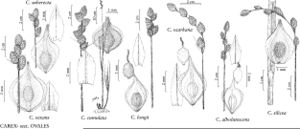Carex cumulata
Bull. Torrey Bot. Club 49: 366. 1923.
Plants densely cespitose. Culms 20–80 cm; vegetative culms with leaf-blades in stiff rosettes. Leaves: sheaths adaxially green-veined nearly to collar, with a white-hyaline band or sharp Y-shaped hyaline region at collar; adaxially firm, summits truncate, prolonged 0.3 mm beyond collar, abaxially finely papillose; distal ligules 2–7 mm; blades 2–4 per fertile culm, 14–30 cm × 3–6 (–8) mm. Inflorescences dense or open, light green or brown, 1.5–4 (–5) cm × 7–16 mm; proximal internode 3–5 (–12) mm; 2d internode 2–9 mm; proximal bracts bristlelike or, sometimes, leaflike. Spikes 3–10, distant, distinct, conic or ovoid, 6–12 × 4–7 mm, base truncate or rounded, apex obtuse; staminate portion 2 mm or less. Pistillate scales white-hyaline or brown, with green or white midstripe extending to tip, broadly lanceolate, 2.8–3.5 mm, shorter and narrower than perigynia, apex firm, obtuse or acute. Perigynia appressed, greenish to dark-brown, conspicuously 3–7-veined abaxially, inconspicuously veined adaxially, obovate, concavo-convex, 3–4.2 × (1.8–) 2–3.2 mm, 0.5–0.7 mm thick, margin flat, including wing 0.5–0.8 mm wide; beak appressed-ascending, brown at tip, flat, ciliate-serrulate, abaxial suture with white or hyaline brown margin, distance from beak tip to achene 1.5–2 mm. Achenes elliptic, 1.7–1.9 × 1.1–1.25 mm, 0.5–0.6 mm thick; styles abaxially-adaxially bent. 2n = 36, 38.
Phenology: Fruiting mid–late summer.
Habitat: Dry to wet, acidic sandy, gravelly, or rocky soils of barrens, acidic woods and thickets, drying peat bogs, often associated with Polytrichum
Elevation: 0–300 m
Distribution

Man., N.B., Nfld. and Labr., N.S., Ont., P.E.I., Que., Conn., Ill., Ind., Maine, Mass., Mich., N.H., N.J., N.Y., Pa., R.I., Vt., Wis.
Discussion
Carex cumulata is infrequent and seldom abundant in the habitats in which it is occurs. All reports of this species from Manitoba and extreme western Ontario, Canada are based upon historic collections made by John Macoun in 1872.
A few collecions appear to be sterile hybrids of Carex cumulata and C. scoparia. Carex cumulata and C. merritt-fernaldii sometimes occur together and frequently are mis-identified. Carex cumulata can be distinguished, however, by its adaxially green and veined sheaths, obovate perigynia and usually broader (3–6 mm) leaves.
Selected References
None.
Lower Taxa
"shortened" is not a number."less" is not a number."+timesaslongasinflorescences" is not declared as a valid unit of measurement for this property."not undefined" is not a number."shorter and narrower" is not a number.
